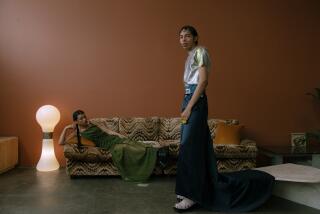AROUND HOME : Notes on Perfect Pasta, Closet Space and French Empire Furniture : French Empire Furniture
- Share via
NEOCLASSICISM LEFT A strong impression on European furniture during the 18th Century. By the beginning of the following century, the trend was even more pronounced, particularly in France, where it reached its most elaborate expression during the First Empire (1804-1814).
In the history of design, there have been few styles so ornate, so heavy, so encrusted with decoration as French Empire furniture. The fact that it was the personal creation of the Emperor Napoleon explains a great deal. Napoleon saw himself as a new Caesar, and he turned to the monumental style of Ancient Rome with the same sort of enthusiasm later shown by Mussolini during Italy’s fascist era.
By 1800, Napoleon was first consul, and even then French furniture was losing the finesse and simplicity it had acquired during the Directoire, when poverty in the wake of the Revolution served to eliminate fancy ormolu and elaborate marquetry. Napoleon had other ideas.
The furniture in which he delighted was made of heavy mahogany from the West Indies; it gleamed with gilt and was mounted with classical motifs. Ormolu decorations depicted classical gods and goddesses, caryatids, lions’ heads and laurel wreaths. The style grew more ornate, more imperial. Take, for example, the typically dramatic armchair covered with Napoleonic emblems (such as the bee) in brass. Such chairs were virtual thrones, the legs and arms often carved with gilt Egyptian figures and Sphinxes (echoing Napoleon’s Egyptian Campaign of 1798-1799). Some interesting pieces were developed for the first time: the meridienne , or chaise longue; the psyche, or cheval, looking glass; the sleigh bed.
Long after Napoleon found himself on the island of St. Helena, the Empire style continued to have an influence. It was reflected in English Regency furniture and later in the more simplified Biedermeier style of Austria and Germany. It crossed the Atlantic, too, in even simpler and more graceful forms, and one of the most neglected phases of Empire style is that plain and handsome furniture made in America about 1850.
As contradictory as it might seem, French Empire furniture has a valid place today. In its simplest form it fits well with contemporary decor, and in its most ornate it serves as a vivid counterpoint to the unadorned. Imagine, for example, a high-tech bedroom with Philippe Starck tables and chairs, but with the focus on some elaborate Empire sleigh bed, rich with golden imperial eagles.
Empire furniture can be found at La Maison Francaise, Paul Ferrante and Melrose House (reproductions) in West Los Angeles; Gisele’s Antiques and John Moran (auctions) in Pasadena; T & R Antiques and Unicorn Mall (100 shops) in San Diego; G.R. Durenberger in San Juan Capistrano, and Richard Yeakel in Laguna Beach.


